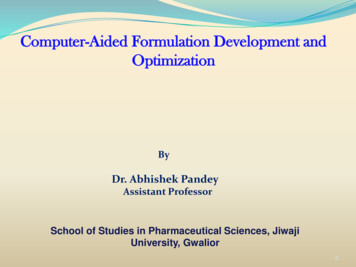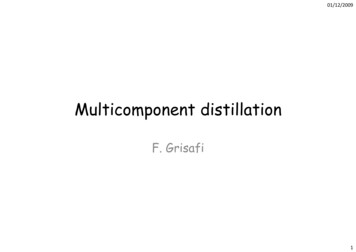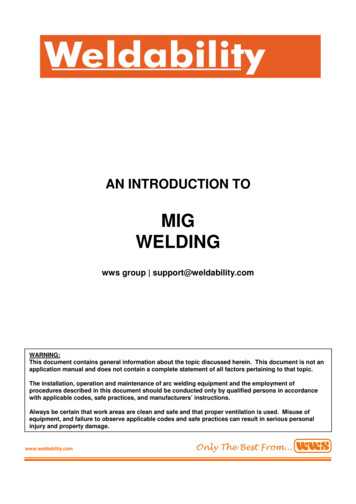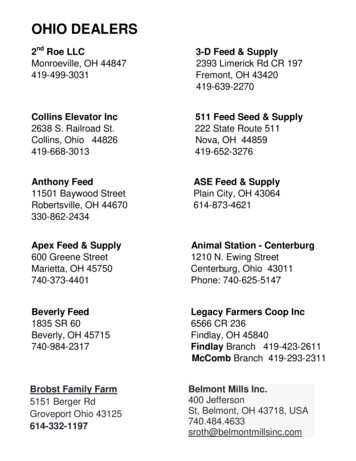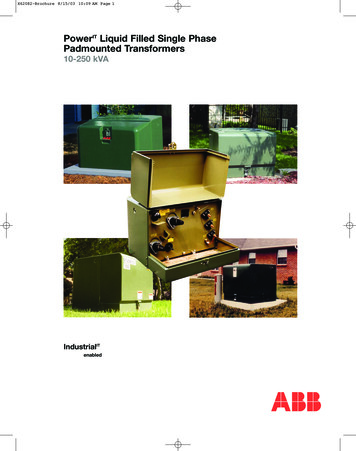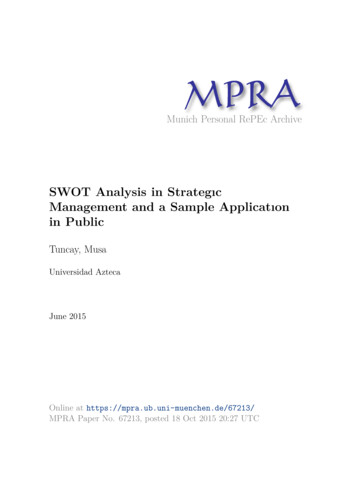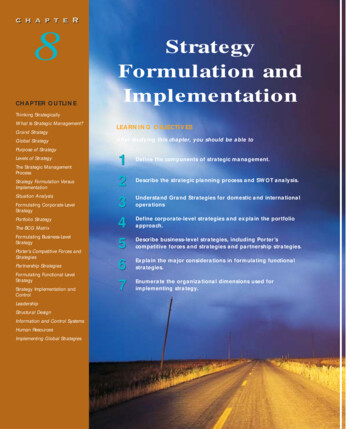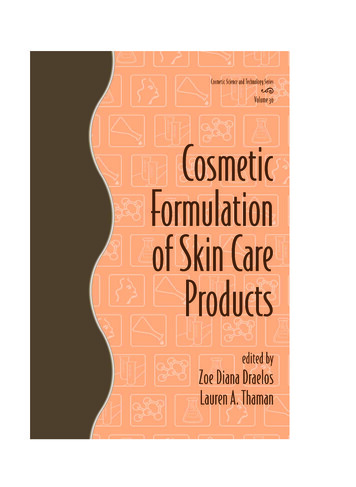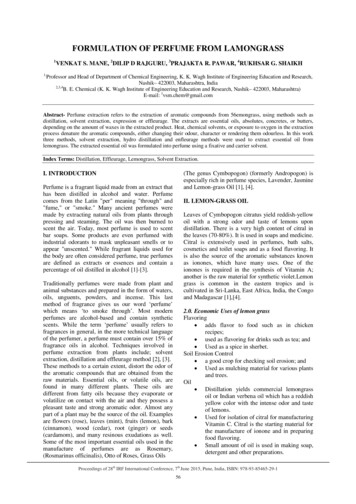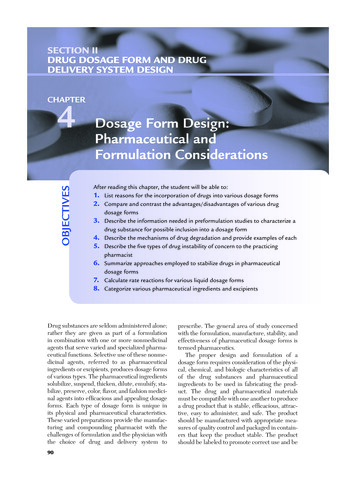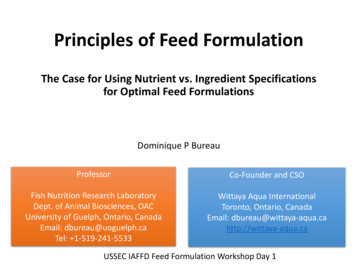
Transcription
Principles of Feed FormulationThe Case for Using Nutrient vs. Ingredient Specificationsfor Optimal Feed FormulationsDominique P BureauProfessorCo-Founder and CSOFish Nutrition Research LaboratoryDept. of Animal Biosciences, OACUniversity of Guelph, Ontario, CanadaEmail: dbureau@uoguelph.caTel: 1-519-241-5533Wittaya Aqua InternationalToronto, Ontario, CanadaEmail: dbureau@wittaya-aqua.cahttp://wittaya-aqua.caUSSEC IAFFD Feed Formulation Workshop Day 1
Most Aquaculture Feed Manufacturers:Have to produce feeds:- for a wide variety of aquatic species and life stages- with different specs for different market needs (eg. different feed grades)- while controlling production costs (i.e. have very low profit margins)- that minimize risks for the corporation and its clients- for clients with different challenges (diseases, limited tech resources)- with costly, variable and “imperfect” ingredients- with limited resources: budget, personnel and timeand Need to:- rely on published studies for generic information (e.g. nutrient specs.)- rely on results from trials provided out by different stakeholders (e.g.feed additive suppliers) for value/usefulness of commercial products
Looking at the Issue from a Broad PerspectiveFeedstuffsAgriculture& fisheriesFeed formulation& manufacturingAnimal husbandryWaste outputs&environmentalimpactsProfitabilityFinal product quality
Adequately and Cost-Effectively Meeting RequirementsKey Strategies:1- Determining nutrient requirements/specifications across life stagesEffective approach:Fine characterization of nutrient requirementsResearch trials / review of literatureUse of nutritional models2- Cost-effectively meeting nutrient requirementsEffective approach:Fine chemical characterization of ingredientsDigestibility trials, in vitro lab analysisUse nutritional models (digestible nutrients)Use additives and processing techniques3- Verifying if predictions correspond to commercial realityEffective approach:Benchmarking / production modelingInvestment in Research & Development (R&D)Never be satisfied with status quo
Balancing our Understanding of NutritionalRequirements and Ingredient Quality
Feed Formulation Feed formulation is the process of quantifying the amounts of feedingredients that need to be combined to form a single uniform mixture(diet) that supplies all of the nutrient required by animal or allow tomeet certain production objectives at a reasonable cost (preferably atthe least cost) Typical formulations indicate the amounts of each ingredient thatshould be included in the diet, and then provide the concentration ofnutrients (composition) in the diet Feed formulations are generally compromise between an idealsituation and practical considerations (cost, availability andcharacteristics of ingredients, etc.).
Feed Formulation – Ingredient Driven
Large variation of chemical composition of DDGS samplescollected from six plants in CanadaMeanSEM (n 12)MinimumMaximumNutrient Content (% as is)Dry Matter87.680.2085.7289.85Crude s0.780.010.590.88Sulphur0.570.020.391.03McEwen et al., 2010; Univ. of Guelph”Same” ingredient but very different nutritional profilesDoes it makes sense to formulate on a % ingredient level then?
Feed Formulation – ProximateAnalysis-Driven
Nutritional Quality of DDGS
The “chemical composition” of crude protein can be highly variableeven in standard ingredients!Variability of Lysine Concentration (% as is) in Relation to Crude Protein (% as is)Content of US Soybean Meal SamplesData courtesy of Paul Smolen and United Soybean Board
Generic names often regroup ingredients that can bewidely different. Not buying a “name”Nutrient Composition of Different Fish Meals and Poultry by-Products MealsCompositionFish mealHerringMenhadenPoultry by-Products MealFeed-grade PrimeRefinedDry matter, %Crude Protein, %Crude fat, %Ash, %Phosphorus, 2.0Lysine, %Methionine, %Histidine, %Threonine, .61.51.53.0Cheng and Hardy (2002)
Nutrient Composition of Different Fish Meals and Poultry by-ProductsMealsCompositionFish mealHerringMenhadenPoultry by-Products MealFeed-grade PrimeRefinedDry matter, %Crude Protein, %Crude fat, %Ash, %Phosphorus, 2.0Lysine, %Methionine, %Histidine, %Threonine, .61.51.53.0Fish meal is not fish meal and poultry by-products meal is not poultry by-products meal.These are generic names that regroup ingredients that can be widely different.Cheng and Hardy (2002)
Apparent Digestibility of Nutrients of Different Fish Meals andPoultry By-Products Meals in Rainbow TroutComponentDry matterCrude ProteinCrude fatFish mealPoultry by-Products MealHerringMenhaden Feed-grade 5929095959392899285829295898593948985Information on EAA content and digestibility is extremely meaningfulfor the formulation of cost-effective feedsCheng and Hardy (2002)
Apparent Digestibility of Different Blood Meals Assessed withthe Guelph SystemApparent DigestibilityDrying TechniqueProteinEnergySpray-dried blood meal96-99%92-99%Ring-dried blood meal85-88%86-88%Steam-tube dried blood meal84%79%Rotoplate dried blood meal82%82%Bureau et al. (1999)Different drying equipments can greatly affect apparent digestibility
Variation in DDGS due to Drying ConditionsLysine concentration tended to be highest in light-colored DDGS and lowest in the darkestcolored DDGS sources. When the four darkest, burnt smelling sources were fed to chicks,growth rate, feed intake, and feed conversion were compared to chicks fed the lightestcolored DDGS. Results from this study suggest that DDGS that is dark in colored and/or hasa burnt smell should not be used in swine or poultry diets.Source: Cromwell, G.L., K.L. Herkleman, and T.S. Stahly. 1993. Physical, chemical, andnutritional characteristics of distiller’s dried grains with solubles for chicks and pigs. J.Anim. Sci. 71:679-686.You can sometimes trust your senses but you have to know what to look for.
nutritional-value-of.html
Ingredient purchasing, feed formulations and researcheffort are all still too often based on: Generic name of ingredients Soybean meal Rapeseed meal Poultry by-products meal Meat and bone meal Blood meal Proximate composition : Crude protein (N 6.25)* Crude lipids (crude fat)* Ash Crude fiber Total phosphorus Pepsin digestibility (?)
Balancing our Understanding of NutritionalRequirements and Ingredient Quality
Fish Oil Replacement in CobiaTrushenski et al. (2012)
In Cobia, the response of the fish to EPA DHA is not robustTrushenski et al. (2012)
Cobia does not appear to respond to EPA !Trushenski et al. (2012)
Trushenski et al. (2012)Cobia responds well to the level of DHA only !DHA is the essential nutrient and what matters!
Fish Oil Replacement in CobiaThe Issue is not Fish Oil vs. Soy OilThe issue is meeting the specific nutrient (DHA) requirement of thefish using an effective source of DHA!What matters is knowing the DHA requirement of the animal andthe DHA concentration of the feed ingredientsTrushenski et al. (2012)
Animals Utilize NUTRIENTSnot “Ingredient”, and not “Proximate Components”What’s important in feed formulation? Individual nutrient requirements of animals (with adequate safety margins) Nutrient content of feed ingredients and associated variability Digestibility and bio-availability of nutrients Potential limitations (e.g. contaminants, anti-nutritional factors) Impacts (e.g. physical properties, waste outputs, final product quality) of theingredients
Adequately and Cost-Effectively Meeting RequirementsKey Strategies:1- Determining nutrient requirements/specifications across life stagesEffective approach:Fine characterization of nutrient requirementsResearch trials / review of literatureUse of nutritional models2- Cost-effectively meeting nutrient requirementsEffective approach:Fine chemical characterization of ingredientsDigestibility trials, in vitro lab analysisUse nutritional models (digestible nutrients)Use additives and processing techniques3- Verifying if predictions correspond to commercial realityEffective approach:Benchmarking / production modelingInvestment in Research & Development (R&D)Never be satisfied with status quo
Precision Feed Formulation Formulation of feed to nutritional specifications thatcorrespond closely to the requirements of the animaland/or production objectives without deficiency or excess Important step towards improving the cost-effectivenessof feeds in aquaculture
Nutritional Specifications Nutritional specifications are guidelines. The are definedcarefully, reviewed occasionally, and generally quite strictlyfollowed by feed formulators to ensure consistency of nutritionalquality of feeds Nutrient restrictions are “practical” values taking into account : Requirements of the animal Production objectives and demands/preferences of the market Feed minimizing cost of formula while maximizing performance Feed resulting in less wastes Feed that is the cheapest per kg of feed Uncertainties Ex: Uncertainties around estimate of nutritional composition,nutritional requirements or potential losses of nutrientsrequiring use of certain safety margin
Nutritional Specifications are Guidelines, Some are Redundantor Sometime not Useful or Relevant
Ingredient Restrictions Generally driven by practical considerations and “gaps” inknowledge Considerations: Effect on processing (handling limitations, effect on pellet quality, etc.) Chemical and/or nutritional characteristics not easily or notadequately addressed through the current nutritional specifications Logistical, risk management and market issues (limited availability,contamination, variability, final product characteristics, customerconcerns, export regulations, etc.) In general, the more we characterize the animals and theingredients, the less important the ingredient specifications.However, some logistical considerations still always play a role
Nutrition, Feed Formulation and Feed ProductionIdentifying Specific Priorities and TasksNutrition &Formulation R&DRaw Material Qualityand QA/QC R&DFeed TechnologyR&DImproved nutritionalspecificationsCharacterization of composition(nutrients and anti-nutritionalfactors)Feed Processing efficiency(energy, labor, wastage)Improved formulation guidelines(ingredient restrictions)Digestibility, bio-availability,nutritive value, LimitationsSpecial Processes (Liquiddosing, enzymes, etc.)Potential of feed additives andother technological solutionsImproved / More efficient QA/QCprocessesModulation of physicalcharacteristics (floatability,stability, fines, etc.)Feed Product Portfolio (Feedgrades, phase-feeding, etc.)Upgrading of ingredient quality(Processing)Special feeds (larval feed, diet toimprove disease or stressresistance, etc.)Feed safety (contaminants) andtraceability
Most Aquaculture Feed Manufacturers: Have to produce feeds: - for a wide variety of aquatic species and life stages - with different specs for different market needs (eg. different feed grades) - while controlling production costs (i.e. have very low profit margins)

